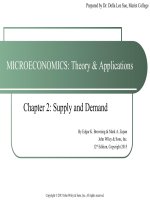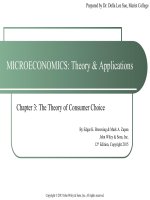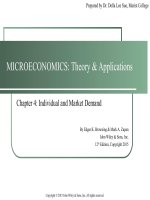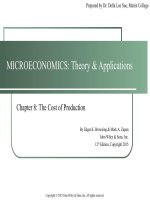MicroEconomics theory and application 12th by browning an zupan chapter 01
Bạn đang xem bản rút gọn của tài liệu. Xem và tải ngay bản đầy đủ của tài liệu tại đây (337.72 KB, 20 trang )
Prepared by Dr. Della Lee Sue, Marist College
MICROECONOMICS: Theory & Applications
Chapter 1: An Introduction to Microeconomics
By Edgar K. Browning & Mark A. Zupan
John Wiley & Sons, Inc.
12th Edition, Copyright 2015
Copyright © 2015 John Wiley & Sons, Inc. All rights reserved.
Learning Objectives
Convey the scope of microeconomic theory.
Explain why theory, is essential to understanding and predicting real-world
outcomes.
Distinguish between positive and normative analyses.
Differentiate between real and nominal prices.
Describe the basic assumptions economists make about market participants.
Introduce the concept of opportunity cost and explain how economic costs
differ from accounting costs.
Show how a production possibility frontier graphically depicts the basic
assumptions economists make about market actors as well as the concept of
opportunity cost.
Copyright © 2015 John Wiley & Sons, Inc. All rights reserved.
2
Convey the scope of microeconomic theory.
1.1 THE SCOPE OF MICROECONOMIC
THEORY
Copyright © 2015 John Wiley & Sons, Inc. All rights reserved.
3
The Scope of Microeconomic Theory
“micro-” derives from the Greek word “mikros-”
Microeconomics
the study of the behavior of small economic units such as
consumers and firms
focuses on individuals as fundamental decision makers in a
society
also referred to as “price theory”
Copyright © 2015 John Wiley & Sons, Inc. All rights reserved.
4
Explain why theory, is essential to understanding and predicting realworld outcomes.
1.2 THE NATURE AND ROLE OF
THEORY
Copyright © 2015 John Wiley & Sons, Inc. All rights reserved.
5
The Nature and Role of Theory
A theory shows how facts are related to one another.
Theory
is based on certain assumptions.
can be used to predict as well as explain real-world
outcomes.
“Good” theory – a theory that successfully explains and
predicts the phenomena that it is intended to explain and
predict.
Copyright © 2015 John Wiley & Sons, Inc. All rights reserved.
6
Distinguish between positive and normative analyses.
1.3 POSITIVE VERSUS NORMATIVE
ANALYSIS
Copyright © 2015 John Wiley & Sons, Inc. All rights reserved.
7
Positive versus Normative Analysis
Positive analysis – assessment of expected objective
outcomes; draws on accepted rules of logic and evidence
Normative analysis – a nonscientific value judgment;
subjective
Copyright © 2015 John Wiley & Sons, Inc. All rights reserved.
8
Differentiate between real and nominal prices.
1.4 MARKET ANALYSIS AND REAL
VERSUS NOMINAL PRICES
Copyright © 2015 John Wiley & Sons, Inc. All rights reserved.
9
Market Analysis and
Real versus Nominal Prices
Markets – the interplay of all potential buyers and
sellers of a particular commodity or service
Nominal price – absolute price, not adjusted for the
changing value of money
Real price - nominal price adjusted for the changing
value of money
Copyright © 2015 John Wiley & Sons, Inc. All rights reserved.
10
Table 1.1
Source
Copyright © 2015 John Wiley & Sons, Inc. All rights reserved.
11
Describe the basic assumptions economists make about market
participants.
1.5 BASIC ASSUMPTIONS ABOUT
MARKET PARTICIPANTS
Copyright © 2015 John Wiley & Sons, Inc. All rights reserved.
12
Basic Assumptions about Market
Participants
Goal-oriented – market participants are interested in
fulfilling their own personal goals
Rational behavior – behavior is based on a careful,
deliberate process that weighs expected benefits and
costs
Scarce resources – availability of resources is insufficient
for individuals to satisfy all desires
Copyright © 2015 John Wiley & Sons, Inc. All rights reserved.
13
Introduce the concept of opportunity cost and explain how economic
costs differ from accounting costs.
1.6 OPPORTUNITY COST
Copyright © 2015 John Wiley & Sons, Inc. All rights reserved.
14
Opportunity Cost
Explicit costs – money used in the pursuit of a goal that
could otherwise have been spent on an alternative
objective
Implicit costs – costs associated with the individual’s use
of his or her own time and other resources in pursuit of
a particular activity
Economic cost (aka “opportunity cost”)
= explicit costs + implicit costs
Copyright © 2015 John Wiley & Sons, Inc. All rights reserved.
15
Other Costs
Accounting costs = costs reported in companies’ net
income statements generated by accountants
Sunk costs = costs that have already been incurred and
are beyond recovery
Copyright © 2015 John Wiley & Sons, Inc. All rights reserved.
16
Show how a production possibility frontier graphically depicts the
basic assumptions economists make about market actors as well as
the concept of opportunity cost.
1.7 PRODUCTION POSSIBILITY
FRONTIER
Copyright © 2015 John Wiley & Sons, Inc. All rights reserved.
17
Production Possibility Frontier
PPF - a depiction of all the different combinations of
goods that a rational actor with certain personal goals
can attain with a fixed amount of resources
Constant versus increasing per-unit opportunity cost –
effect on shape of PPF
Constant opportunity costs: linear
Increasing opportunity costs: concave to the origin
Copyright © 2015 John Wiley & Sons, Inc. All rights reserved.
18
Figure 1.1 - A Production Possibility
Frontier (PPF)
Copyright © 2015 John Wiley & Sons, Inc. All rights reserved.
19
Figure1.2 - The Typical-Case PPF:
Concave to the Origin
Copyright © 2015 John Wiley & Sons, Inc. All rights reserved.
20









